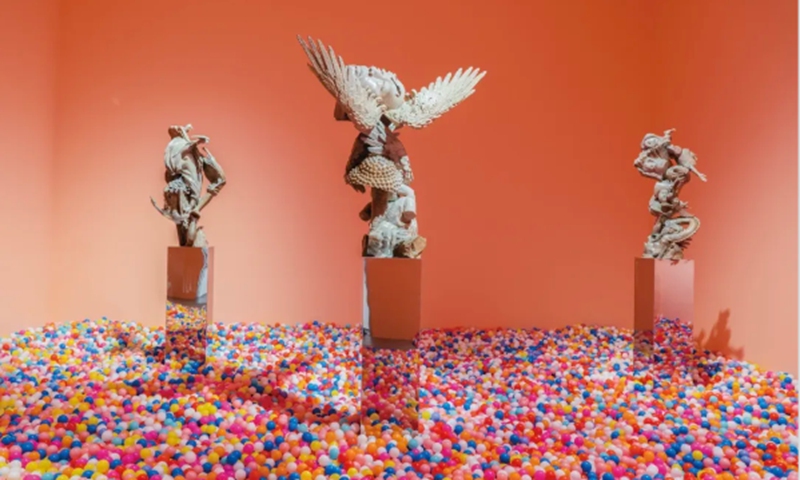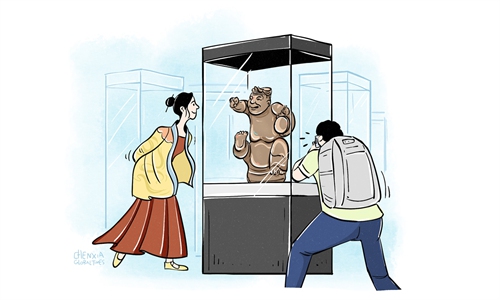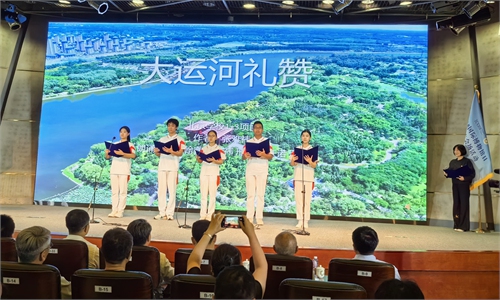ARTS / CULTURE & LEISURE
University museums transform from ‘academia-oriented’ to engage wider public

The artwork by Chinese artist Jiao Xingtao at the "Symphony of Coexistence — Chinese and Southeast Asian Art Invitational Exhibition" held in the Art Museum of Sichuan Fine Arts Institute Photo: Courtesy of the Art Museum of Sichuan Fine Arts Institute
There are more than 400 university museums in China, with specialist themes ranging from geological specimens to tax receipts. Different from registered public museums, the main highlight of such university showrooms are their niche displays, which update visitors on the research climates of Chinese higher-education facilities.
As university museums are like "standard equipment intrinsic to the university itself," these facilities were traditionally used by a small section of the academic world, Dou Saiming, a cultural policy expert, told the Global Times, adding that a university museum was something akin to a cultural salon.
China has an abundant number of university museums as it boasts a large number of university facilities. In East China's Jiangsu Province, there are nearly 70 museums of various sizes located within the province's 51 universities.
However, the public rarely knew about university museums until recently, with their enthusiasm for them shedding light on university museums' transformation.
How have they changed, and what was the common goal behind this transformation? These two questions can be answered by exploring several aspects including university museums' creative content, their social responsibility, and their participation in the booming cultural tourism sector.
At the Art Museum of Sichuan Fine Arts Institute in Chongqing Municipality, although "visual arts" is the site's constant theme, its recent show "Symphony of Coexistence: Chinese and Southeast Asian Art Invitation exhibition" interpreted that theme through a novel angle. By displaying works created by 41 artists from countries such as China and Thailand, the show contextualized arts in the Belt and Road Initiative (BRI).
The decision to combine "art and BRI" at an exhibition shows the art institution's cultural sense of engaging in social topics, through which it connects not only to artists and students, but also to the public.
Gao Shiming, a renowned art educator who was the president of the China Academy of Art, said that "art must truly connect with the minds and hearts of all people."
Gao has also emphasized that art institutions should "effectively integrate academic knowledge with social knowledge to create an educational model rooted in the Chinese context."
The tenet of making art matter to the public and connect to society is a common goal that many university museums seek to achieve. Other than art-oriented museums, facilities such as the Shandong University Museum and the Museum of Chengdu University of Technology have all turned their specialties of "archaeology" and "paleontology" into sources of public education. Their museum displays employ 3D installation and interactive designs to provide visitors with immersive experiences.
"An exhibition has to be made accessible, engaging and experiential to the public," Dou, the expert emphasized. He noted that the level of "popularity and the quality of exhibits" in many university museums have already reached a par with that of many public museums.
"So far in 2024, the audience number has reached 170,000, and we expect it to exceed 200,000 this year," said Xiao Guitian, the deputy director of Shandong University Museum.
Following the growing cultural confidence of Chinese people, the public's passion for museum tours has become a promising sector contributing to the country's cultural tourism growth. Many university museums have also started to participate in the sector.
Driven by the tourism boom in Harbin, Northeast China's Heilongjiang Province, the museum attached to Harbin Engineering University has put on a themed show focusing on the city's military history.
After the "mountain city" became an international sensation, the Art Museum of Sichuan Fine Arts Institute has become a hot spot attracting nationwide travelers.
Connecting university museums to the public can allow them to see the openness of the Chinese educational system. For the universities themselves, this approach helps them showcase their value to society.
The author is a reporter with the Global Times. life@globaltimes.com.cn



